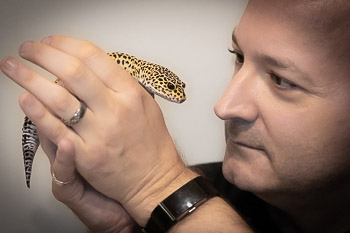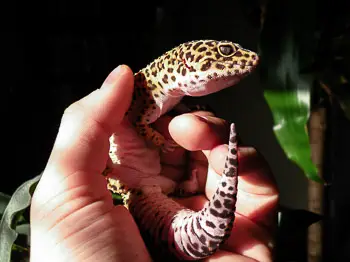As humans, we often associate the night with darkness and a lack of visibility. It’s a symbol of mystery, fear, and the unknown. But for some animals, like leopard geckos, the night is just another opportunity to explore and thrive. These fascinating creatures have adapted to life in low light environments and are even capable of seeing in complete darkness.
Leopard geckos can see in the dark and navigate their environment without the use of bright lights.
If you’re a leopard gecko owner or simply curious about these amazing creatures, join us as we delve into their world of darkness and discover just how much they can see.
Leopard Gecko Night Vision
We’re excited to delve into the subtopic of Leopard Gecko night vision! As crepuscular animals, these geckos have adapted to be able to see in the dark. In fact, leopard geckos have a variety of unique adaptations that allow them to navigate and hunt in the darkness.
They have specialized eyes with large pupils, a tapetum lucidum, and a high concentration of rod cells to help them see in low light conditions. They can distinguish color at night better than humans.
We’ll explore how these adaptations have helped Leopard Geckos thrive in their natural habitats.
How have Leopard Geckos Adapted for Night Vision?
It’s fascinating to learn how these little creatures have evolved to thrive in low-light conditions. Leopard geckos have adapted to their nocturnal lifestyle through various mechanisms, one of which is their retina structure.
A study of nocturnal color vision in geckos found that geckos active at night developed retinas lacking rods but with three types of cones. The cones empower geckos with color vision at very dim light levels. Humans and many other vertebrates rely on rods in low light, which cannot detect color.
Additionally, leopard geckos possess a specialized layer of tissue behind their retina called the tapetum lucidum, which reflects light back through the retina and enhances their visual sensitivity. This adaptation is particularly useful for nocturnal navigation, as it allows them to see obstacles and potential prey more clearly in the dark.
Related Post: Did you know leopard geckos are one of the few species that can blink? Click the link and find out more about leopard gecko eyes.
Lighting Your Leopard Gecko’s Tank
Creating the right lighting environment for your pet can be crucial for their overall health and well-being. As a leopard gecko owner, it’s important to understand the different lighting options available for your pet’s tank.
You can create a comfortable and healthy habitat for your leopard gecko by providing appropriate lighting. Contrary to popular belief, leopard geckos are not nocturnal lizards (though they are more active at night than during the day.) They’re crepuscular, meaning that they are most active during twilight hours between night and day. Either way, they rely on their keen sense of sight to navigate in dark and low light conditions.
When it comes to lighting your leopard gecko’s tank, it’s important to strike a balance between providing a necessary light supply and not disrupting their sleep cycle.
A good rule of thumb is to provide 12 hours of light and 12 hours of darkness each day. You can achieve this by using a low-wattage bulb or a specialized UVB bulb that provides the necessary light without being too bright. There are some opposing thoughts on whether UV light (UVA and/or UVB) is necessary – these lights help reptiles get vitamin D, though leopard geckos are usually not out during daylight hours.
Having a well defined day/night cycle is critical. You can put this on autopilot with timers or smart plugs. A simple outlet or Christmas light timer will do the trick, though we prefer using a Smart Plug instead of a timer. It’s a simpler set it and forget it, and can automatically adjust for changes in sunset and sunrise times. Here’s the one we use:

Remember, too much light can stress out your leopard gecko and disrupt their natural sleep patterns, so it’s important to get the day/night cycle right.
That said, your leopard gecko does not need any special lighting at night. Anything you do here is more for you to see your gecko than anything else. However, your gecko’s enclosure should maintain temperature at night, so you should still consider a heat source.
You may choose to use a heat lamp or an under tank heating pad, but it’s important to ensure that the temperature isn’t too hot or too cold for your gecko. Read this post for more on your leopard gecko’s heating needs.
About Leopard Gecko Vision
You may not realize it, but understanding how your pet perceives the world around them can greatly enhance your bond and provide insight into their behavior.
Here are four things you need to know about gecko eyesight:
1. Leopard geckos have excellent night vision due to their large pupils and specialized retinas. They’re able to detect prey in low light conditions and hunt efficiently in the dark.
2. Environmental factors such as lighting and temperature can impact a gecko’s eyesight. Too much bright light can cause discomfort and stress, while too little light can affect their ability to see and hunt. They typically hunt at dusk and dawn, when there is dim light and less danger from potential predators.
3. Leopard geckos have evolved genetic adaptations to enhance their visual capabilities. They have a high density of rod cells in their retinas, which are responsible for detecting light in low light conditions.
4. Prey detection is a crucial aspect of leopard gecko vision. Their eyes are positioned on the top of their head, allowing them to scan their surroundings for potential prey while remaining hidden from predators.
Understanding how gecko eyesight works can help you provide the optimal environment for your pet. By providing appropriate lighting and temperature, you can ensure that your leopard gecko’s vision is functioning at its best. It’s also important to note that while they have excellent night vision, they still require some light during the day to maintain their circadian rhythm.
Wrap Up – Can Leopard Geckos See in the Dark?
Leopard geckos can see in the dark. Their unique eyes allow them to see objects clearly even in dim light conditions, making them excellent low light hunters. Their eye structure is designed to gather as much light as possible, and they have more rods than cones, which allows them to see well in low light conditions.
As pet owners, it’s important to provide proper lighting for their tanks to ensure their health and happiness. Your pet gecko doesn’t need any special lighting at night – darkness is just fine. Night lights would allow you to see your gecko, though are not necessary for your gecko to see.
So next time you’re watching your leopard gecko navigate their tank in the dark, remember that they are relying on their incredible night vision to do so!





